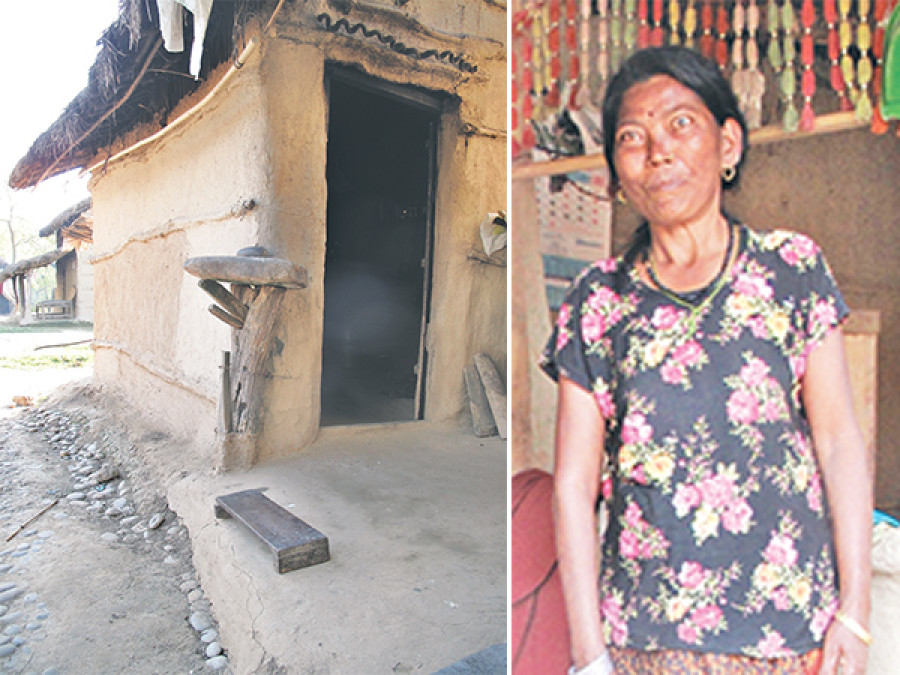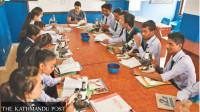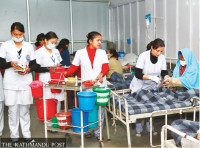Miscellaneous
Just beyond the margins
The confluence of the Narayani and Rapti rivers, at Golaghat Village, Meghauli Municipality, some 30 km southwest of Bharatpur
Tiku Gauchan
But on the fields belonging to Golaghat’s farmers, there are ominous signs all around. The stalks of corn that were planted there months ago are now bent and crushed, and the signs all point to a rhino’s having forayed into the area recently: there are large mounds of rhino droppings dotting the fields. The farmers in this corner of Chitwan live with two perennial fears: of the rivers’ overrunning their banks during the monsoon and of the wild animals’ eating their crops year-round. Many families have given up on farming as a livelihood altogether: the menfolk have mostly left for the Gulf and the women subsist on the scant harvests they can rustle up in their small landholdings. And then there are families like Ram Kumari Kumal’s, who have nothing to go on.
On a recent trip to Meghauli, I came across Ram Kumari, whose house lies just half a kilometre north of the Narayani-Rapti confluence. She was seated on the porch fronting her house, just across from the courtyard, which abuts the road that snakes all the way to Bharatpur, the headquarters of Chitwan. The house was a small hut made of mud, fortified by reed stalks from the nearby buffer-zone forests and topped with a tin roof. On the courtyard were a she-goat tethered to a stake, a hen confined to a nesting area made by a basket placed over it, and another mother hen racing around the yard with her brood of chicks. Across the courtyard, past a tube well and beyond a short hedge, lay the family’s fields, on which had been planted corn and pulses. Two katthas of that family plot is farmed by Sita Kumal, Ram Kumari’s daughter-in-law.
As I approached Ram Kumari, she stood up to talk to me, and I noticed that she had to lift her right arm, which hung limp, with her left, in order to walk towards me. Her left eye seemed to bulge and walking seemed to take quite a bit of effort. As I got talking to her, I learned that she had suffered a stroke some six years ago, when she had been foraging for firewood in the nearby forest, and had to be carried home by villagers.
Ram Kumari, who is 45, in many ways represents how difficult it is to get by for the most vulnerable members of society living in an area that is prone to floods and incursions by wild animals. The buffer zone’s deer, rhinos and wild boars eat the crops growing in the family’s field, and during the monsoon, the Rapti and Narayani rivers inundate the entire area. There is no early-warning system in the village, and the villagers have to make a run for it when the flood water sweeps everything in its path. For someone like Ramkumari, who can barely walk properly, getting away can be exceedingly difficult.
Today, Ram Kumari is on amlodipine, as recommended by the doctors in a Bharatpur hospital. The medicine keeps in check her high-blood pressure, a condition that probably caused her stroke. Sita says that she and her husband would help Ram Kumari get over the lingering after-effects of the stroke if they could, but they do not have enough money.
It’s not that Sita and her husband haven’t sacrificed much for Ram Kumari. Just until last year, Sita and her husband were working in an office pantry in Gurgaon, India, making tea for the office staff. Ram Kumari was being cared for by her husband, but then he died after suffering a stroke six months ago. Sita and her husband decided to quit their jobs, and together with their six-year-old daughter, returned to their village, to take care of Ram Kumari.
But things haven’t been getting better for the family. Sita’s husband cleans rooms at a hotel in Sauraha, for which he gets paid Rs 5,000 a month. Sita farms the two katthas of land that has been bequeathed to her and her husband; but she doesn’t have much hope that the crops will survive till harvest time. Sita worked at a thread mill for a few months recently, but the workplace was too dusty to continue working in, and the mill itself has now shut down. The chickens running around in the yard are not being reared to be sold, and thus do not figure as a source of income for the family. They will be sacrificed during ceremonies to propitiate the gods. The goat in the family’s yard actually belongs to their neighbour. Ram Kumari and Sita are only taking care of it on the neighbour’s behalf. When it has kids, the neighbour will get the goat back and the kids will be shared between the neighbour and Ram Kumari’s family.
The family will probably never be able to afford the treatment needed to alleviate the problems brought about by Ram Kumari’s stroke. Sita’s daughter is already of school-going age, and the family must save to put her through school. For families such as Ram Kumari’s, who can’t make a livelihood through their farms, one major illness in the family can affect everyone.
Ram Kumari’s village is just 30 km away from the bustling cities of Bharatpur and Narayanghat—fast-growing cities whose main roads are lined with luxury resorts, supermarkets, housing colonies and hospitals. The road that leads into the deep interiors of Meghauli is lined with business ventures propped up by remittance money: bike repair shops, restaurants, fish ponds and chicken farms. But as the road approaches Meghauli, the concrete houses give way to mud huts and brown fields.
Amidst this browning landscape, Ram Kumari still clings onto a story of hope that she has created for herself. She wants to believe that the spirit of her late husband, who cared for her until his death, now resides in the goat she is looking after. She hopes that the goat will give birth to female kids—for that will mean she can then start a small goat farm with their offspring.
It’s a hope as dreamlike in its contours as the confluence point that lies a little to the south of her mud hut.




 24.05°C Kathmandu
24.05°C Kathmandu










